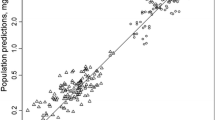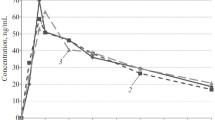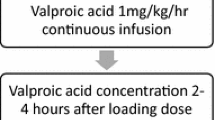Abstract
The diurnal fluctuations in dipropylacetic acid (DPA) plasma levels were examined in ten epileptic patients following a chronic treatment with 3 or 2 daily doses of dipropylacetamide (DPM). The highest/lowest DPA level ratios observed throughout 24 hrs were 1.18 and 1.36, respectively, but the difference in the data was not statistically significant (p>0.05). The present results indicate that a reduction of the frequency of the daily administrations of the drug can be made with consequent possible improvement in the patient's compliance. The clinical value of the oscillations in DPA serum levels is also revised in the light of the data reported in the literature.
Sommario
Le fluttuazioni giomaliere dei livelli plasmatici di acido dipropilacetico (DPA) sono state esaminate in 10 pazienti epilettici in trattamento cronico con 3 o 2 dosi giomaliere di dipropilacetamide (DPM). I rapporti valore più alto/valore più basso di livello di DPA osservati nelle 24 ore sono risultati 1.18 e 1.36, rispettivamente, ma la differenza dei dati non è stata significativa (p>0.05). I presenti risultati indicano che può essere effettuata una riduzione della frequenza delle somministrazioni giomaliere del farmaco con un conseguente possibile miglioramento della “compliance” del paziente. Il valore clinico delle oscillazioni dei livelli serici di DPA è inoltre rivisto alla luce dei dati riportati in letteratura.
Similar content being viewed by others
References
Chadwick D.W.,Turnbull D.M.,Weightman D.,Rawlins M.D.:Clinical value of valproate levels. 14th Epilepsy International Symposium, London, August 15–18, 1982, (abstracts), pp. 87.
Chard C.R.:A simple method for the determination of Epilim in serum. In: Legg (Ed.), Clinical and Pharmacological Aspects of Sodium Valproate (Epilim) in the Treatment of Epilepsy. MCS Consultants, Tunbridge Wells, 1976, pp. 89–91.
Covanis A.,Jeavons P.M.,Gupta A.K.:Monotherapy with once daily sodium valproate. 12th Epilepsy International Symposium, Copenhagen, September 6–10, 1980, (abstracts), pp. 59.
Odusote K.A. Sherwin Amendola A.L.A.:A simple direct extraction method for gas-liquid determination of valproic acid in plasma.Ther Drug Monit., 3, 103–106, 1981.
Lockard L.S., Levy R.H., Congdon W.C., Du Charme L.L. andPatel I.H.:Efficacy testing of valproic acid compared to ethosuximide in monkey model: II. Seizure, EEG, and diurnal variations. Epilepsia, 18, 205–224, 1977.
Loiseau P., Brachet A., Henry P.:Concentration of dipropylacetate in plasma. Epilepsia, 16, 609–615, 1975.
Meinardi H., Hanke N.F.S., VanBeveren J.:Sodium di-n-propylacetate. Estimation of effective serum levels. Pharm. Wekbl., 109, 45–47, 1974.
Meijer J.W.A. andKalff:Less usual ways of administering antiepileptic drugs. In: H. Schneider, D. Janz, Gardner-Thorpe, H. Meinardi, A.L. Sherwin, (Eds.), Clinical Pharmacology of Anti-Epileptic Drugs. Springer-Verlag, Berlin, Heidelberg, New York, 1975, pp. 222–228.
Perucca E., Gatti G., Frigo G.M., Crema A.:Pharmacokinetics of valproic acid after oral and intravenous administration. Br. J. Clin. Pharmacol., 5, 313–318, 1978.
Perucca E., Gatti G., Frigo G.M., Crema A., Calzetti S., andVisentini D.:Disposition of sodium valproate in epileptic patients. Br. J. Clin. Pharmacol., 5, 495–499, 1978.
Pisani F., Amendola D'Agostino A., Fazio A., Oteri G., Primerano G. andDi Perri R.:Increased dipropylacetic acid bioavailability from dipropylacetamide by food. Epilepsia, 23, 115–121, 1982.
Pisani F. andDi Perri R.:Some clinical pharmacological aspects of n-dipropylacetamide. It. J. Neurol. Sci., 4, 245–249, 1980.
Pisani F., Fazio A., Oteri G., andDi Perri R.:Dipropylacetic acid plasma levels;diurnal fluctuations during chronic treatment with dipropylacetamide. Ther. Drug Monitor., 3, 297–301, 1981.
Pisani F., Fazio A., Oteri G., andDi Perri R.:A study on the metabolism of dipropylacetamide to dipropylacetic acid in rats. J. Pharm. Pharmacol., 34: 45–46, 1982.
Rcihens A., Scoular I.T., Ahmad S., Jordan B.J.:Pharmacokinetics and efficacy of Epilim in patients receiving long-term therapy with other anti-epileptic drugs. In: Legg. (Ed.), Clinical and Pharmacological Aspects of Sodium Valproate (Epilim) in the Treatment of Epilepsy, MCS Consultants, Tunbridge Wells, 1976, pp. 78–88.
Rowan A.J., Binnie C.D., Warfield C.A., Meinardi H., andMeijer J.W.A.:The delayed effect of sodium valproate on photoconvulsive response in man. Epilepsia, 20, 61–88, 1979.
Rowan A.J., Meijer J.W.A., Binnie C.D., De Beer-Pawlikowski N., Gutter Th., Goedhart D., van derGeest P., andMeinardi H.:Sodium valproate and sodium valproate-ethosuximide combination therapy: intensive monitoring studies. In: Johannessen S.I., Morselli P.L., Pippenger C.E., Richens A., Schmidt D., Meinardi H., (Eds.), Antiepileptic Therapy: Advances in Drug Monitoring, Raven Press, New York, 1980, pp. 161–168.
Rowan A.J.,Overweg J.,Meijer I.W.A.:Monodose therapy with valproic acid: 24 hours telemetric EEG and serum levels studies. 12th Epilepsy International Symposium, Copenhagen, September 6–10, 1980, (abstracts), pp. 59.
Sackellares J.C., Sato S., Dreifuss F.E., andPenry J.K.:Reduction of Steady-State Valproate Levels by Other Antiepileptic Drugs. Epilepsia, 22, 437–441, 1981.
Schmidt D.:Fluctuation of dipropylacetate plasma levels with one and three daily doses. In: Vree T.B. and van der Klein, (Eds), Pharmacokinetics and metabolism of the antiepileptic drug sodium valproate (Depakine, Epilim), Bonn, Scheltema & Holkema, Utrecht, 1977, pp. 22–23.
Schobben F., van derKleijn E., Gabreels F.M.J.:Pharmacokinetics of di-n-propylacetate in epileptic patients. Eur. J. Clin. Pharmacol., 8, 97–105, 1975.
Zaccara G. andGalli A.:Effectiveness of Simplified Dosage Schedules on the Management of Ambulant Epileptic Patients. Eur. Neurol., 18, 341–344, 1979.
Wulff K., Flachs H., Wurtz-Jorgensen A., Gram L.:Clinical pharmacological aspects of valproate sodium. Epilepsia, 18, 149–157, 1977.
Author information
Authors and Affiliations
Rights and permissions
About this article
Cite this article
Pisani, F., Spina, E., Trunfio, C. et al. Intra-daily oscillations in dipropylacetic acid plasma levels with two or three daily doses of dipropylacetamide in epileptic patients. Ital J Neuro Sci 4, 173–177 (1983). https://doi.org/10.1007/BF02043901
Issue Date:
DOI: https://doi.org/10.1007/BF02043901




